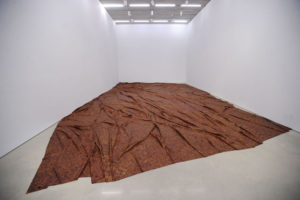
Credit: wmagazine.com
Earlier this year, Harvard Art Museum featured an exhibit called “Doris Salcedo: The Materiality of Mourning” featuring works by renowned Bogota-based, Colombian artist Doris Salcedo. Salcedo is known for her sculptures and installations that address and respond to the political violence and oppression in Colombia and around the world. Her installation “Plegaria Muda,” featured a room set up to resemble a cemetery with large oblong tables as stand-ins for unmarked graves. It commemorated the 25,000 Colombians killed by the army between 2003 and 2009, as well as the thousands who have died as a result of gang violence on the streets of Southeast Los Angeles.
In 2002, Doris Salcedo spent 53 hours suspending 280 old wooden chairs from the roof of Colombia’s Palace of Justice. She then slowly lowered them on the anniversary of the Colombian army’s attack on left-wing guerrillas who seized the Palace in 1985. The chairs represented the lives lost during the attack.
Salcedo has called Colombia “the country of unburied dead” and says the political violence she’s witnessed as a Colombian has given her context to understand political violence around the world. It gives her, she says, “structure that allows me to understand what is happening everywhere.” And, she adds, “what is happening everywhere” is a state of undeclared civil war in which “there are no longer soldiers and civilians, you can no longer locate a a specific battlefront, but it could be anywhere.”

A Flor de Piel, 2014
Credit: pamm.org
“The Materiality of Mourning” is comprised of four separate installations featuring works created between 2001 and 2017. The pieces in the exhibit dealt with grief, loss, mourning, violence in the public sphere, and how the fallout of personal and collective grief exists in those that survive. They address tragedies specific to Colombia, and respond to different types of violence in different areas as well.
For example, a number of more recent pieces were inspired by conversations Salcedo had with mothers in Chicago who had lost children to gang violence. In one installation, called “Disremembered,” Salcedo hung four transparent shirt sculptures woven out of silk thread and nearly 12,000 needles from the wall. The shirts hold shape as if they were draped on bodies — absent bodies, bodies that won’t ever shape the folds of a shirt again. The nickel-plated steel and fine silk thread alternately glint and disappear when the shirts are viewed from different angles, reflecting the way that memory oscillates, fading and reemerging.
“A Flor de Piel” is a room-size tapestry made up of thousands of hand-sewn red rose petals, sutured together into a shroud for a nurse who was tortured during the Colombian War. The title of the piece is a Spanish idiom used to express the state of being in which a person is overcome by emotions to the extent that the emotions are physically expressed through the color of the skin.
Another installation, “Thou-less” is made up of stainless steel chairs, cast from one single wooden chair and then contorted and dented and crumpled. They are hand carved to reproduce the wear and tear of the wood. The chairs are disorderly, strewn about, evoking the presence of the humans who might have occupied the seats and their loud absence.
In “Untitled,” Salcedo pays homage to the weight of grief and loss. One of the “Untitled” sculptures is comprised of four stacked bureaus, each with a worn table at the top of the stack. The chests are filled with blocks of concrete. The pieces burden the floor with their heaviness. The two combined Untitled furniture pieces have a combined weight of 1,800 pounds.

Credit: harvardartmuseums.org
The work of Doris Salcedo work reflects a curiosity around pushing the poetic boundaries of using domestic materials to speak to the subjects of grief and loss. It also reflects a commitment to remembering the victims of tragedy, honoring the anguish of their survivors, and taking the process and importance of mourning seriously. “If we as a society were able to mourn,” Salcedo says, “there would be fewer victims. Violence is unstoppable because nobody cares.”

 “Doris Salcedo: The Materiality of Mourning” Reflects on Grief and Loss
“Doris Salcedo: The Materiality of Mourning” Reflects on Grief and Loss


 John Mulaney’s “Funeral Planning” on Netflix: No Real Plan
John Mulaney’s “Funeral Planning” on Netflix: No Real Plan

 Composting Bodies Is Now Legal in a Dozen States
Composting Bodies Is Now Legal in a Dozen States














